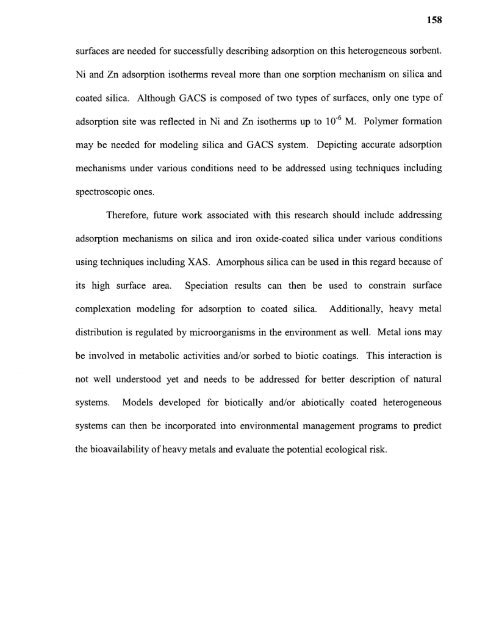Heavy metal adsorption on iron oxide and iron oxide-coated silica ...
Heavy metal adsorption on iron oxide and iron oxide-coated silica ...
Heavy metal adsorption on iron oxide and iron oxide-coated silica ...
Create successful ePaper yourself
Turn your PDF publications into a flip-book with our unique Google optimized e-Paper software.
158surfaces are needed for successfully describing <str<strong>on</strong>g>adsorpti<strong>on</strong></str<strong>on</strong>g> <strong>on</strong> this heterogeneous sorbent.Ni <strong>and</strong> Zn <str<strong>on</strong>g>adsorpti<strong>on</strong></str<strong>on</strong>g> isotherms reveal more than <strong>on</strong>e sorpti<strong>on</strong> mechanism <strong>on</strong> <strong>silica</strong> <strong>and</strong><strong>coated</strong> <strong>silica</strong>. Although GACS is composed of two types of surfaces, <strong>on</strong>ly <strong>on</strong>e type of<str<strong>on</strong>g>adsorpti<strong>on</strong></str<strong>on</strong>g> site was reflected in Ni <strong>and</strong> Zn isotherms up to 10 .6 M. Polymer formati<strong>on</strong>may be needed for modeling <strong>silica</strong> <strong>and</strong> GACS system. Depicting accurate <str<strong>on</strong>g>adsorpti<strong>on</strong></str<strong>on</strong>g>mechanisms under various c<strong>on</strong>diti<strong>on</strong>s need to be addressed using techniques includingspectroscopic <strong>on</strong>es.Therefore, future work associated with this research should include addressing<str<strong>on</strong>g>adsorpti<strong>on</strong></str<strong>on</strong>g> mechanisms <strong>on</strong> <strong>silica</strong> <strong>and</strong> ir<strong>on</strong> <strong>oxide</strong>-<strong>coated</strong> <strong>silica</strong> under various c<strong>on</strong>diti<strong>on</strong>susing techniques including XAS. Amorphous <strong>silica</strong> can be used in this regard because ofits high surface area. Speciati<strong>on</strong> results can then be used to c<strong>on</strong>strain surfacecomplexati<strong>on</strong> modeling for <str<strong>on</strong>g>adsorpti<strong>on</strong></str<strong>on</strong>g> to <strong>coated</strong> <strong>silica</strong>. Additi<strong>on</strong>ally, heavy <str<strong>on</strong>g>metal</str<strong>on</strong>g>distributi<strong>on</strong> is regulated by microorganisms in the envir<strong>on</strong>ment as well. Metal i<strong>on</strong>s maybe involved in metabolic activities <strong>and</strong>/or sorbed to biotic coatings. This interacti<strong>on</strong> isnot well understood yet <strong>and</strong> needs to be addressed for better descripti<strong>on</strong> of naturalsystems. Models developed for biotically <strong>and</strong>/or abiotically <strong>coated</strong> heterogeneoussystems can then be incorporated into envir<strong>on</strong>mental management programs to predictthe bioavailability of heavy <str<strong>on</strong>g>metal</str<strong>on</strong>g>s <strong>and</strong> evaluate the potential ecological risk.
















